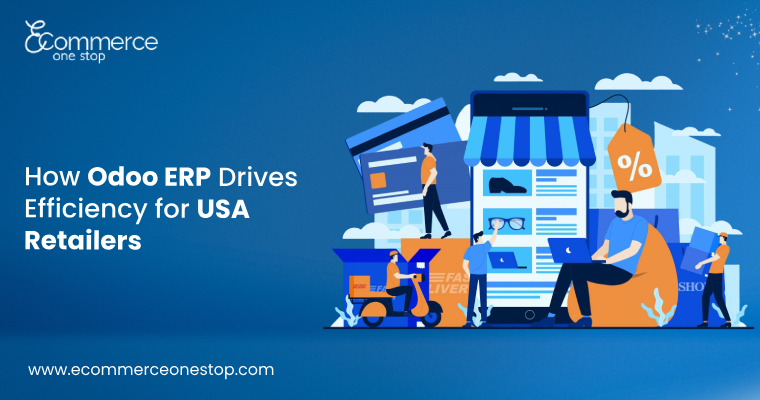Odoo ERP is an integrated platform that centralizes retail operations, helping USA retailers automate tasks and sync data across sales channels.
With USA e-commerce sales set to hit about $1.3 trillion by 2025 (
Oberlo), retailers need strong digital tools. Odoo covers everything from
website development to inventory management in one suite, so stores run efficiently.
Retailers using Odoo see workflow improvements:
- Unified data: Sales, inventory, and customer info update instantly in one system.
- Automated tasks: Manual tasks like order entry and restocking are reduced.
- Stock accuracy: The Odoo inventory management system tracks stock levels to prevent overselling.
- Omnichannel: POS and online sales sync so every transaction is recorded.
Get Your Project Started
Book a free consultation with our Ecommerce experts.
Connect Now

What is Odoo ERP and why do retailers choose it?
Odoo ERP is a business suite that covers apps like sales, accounting, and inventory. Retailers pick Odoo because it bundles key functions under one platform. Odoo serves 25,000+ companies worldwide (
6sense). Instead of juggling separate tools for websites, accounting, and stock, Odoo provides a single system. This integration cuts duplicate data entry and errors.
In short, Odoo acts as a central hub for retail operations, giving managers a single place to view sales, customer data, and inventory levels.
How can Odoo integrate websites, e-commerce, and sales?
Odoo’s website and e-commerce modules let retailers create online stores without extra tools. A site built via
Odoo website development ties directly to the inventory and sales database. Orders update stock levels and trigger shipping processes instantly. Customer info also flows into the CRM.
- Single inventory: Each online sale or in-store purchase updates the same stock database, so managers always see real-time levels.
- Multiple stores: You can run several online shops and physical outlets from one platform.
- Marketing integration: Data from online and offline sales helps tailor promotions or loyalty programs within Odoo.
How does Odoo improve inventory management for retailers?
Stock control is critical in retail. Odoo’s inventory management system offers automated reordering, batch tracking, and barcode scanning. It can cut manual errors by about 70%. In practice, Odoo can auto-generate purchase orders when stock is low and track product variants (size, color). Here are key features:
| Odoo Module |
Retail Benefit |
| Website & E-commerce |
Builds an online store linked to inventorys |
| Inventory Management |
Tracks stock in real time; prevents overselling |
| Point of Sale (POS) |
Syncs in-store sales with online inventory |
| CRM & Marketing |
Stores customer data for targeted offers |
Each sale, online or in-store, automatically updates inventory and accounting, giving managers a clear view of operations.
Why work with an Odoo development service?
Customizing or deploying Odoo often needs expert help. An
Odoo development service ensures the platform fits unique retail needs. Experts can integrate payment gateways, shipping carriers, and local tax rules to avoid mistakes.
Odoo’s code base means stores can add features or reports as needed. Most companies report a positive return on ERP investments. With proper setup and training, retailers see faster returns and smoother operations.
Conclusion
For retailers facing rising online sales, Odoo ERP offers a proven path to efficiency. By unifying websites, e-commerce, inventory, and sales, stores avoid data silos and manual processes. As Deloitte notes, many retailers are pushing for
AI and
automation in 2025 (
Deloitte, 2025). Odoo is ready to support these moves.
50%+ of companies prefer cloud ERP for scalability and cost savings (
NetSuite, 2024). Odoo’s cloud is growing fast.
Connect with us to explore our Odoo ERP development services. Our experts can tailor Odoo for your store’s needs and help you get ahead in the competitive market.
FAQs:
1. Is Odoo ERP suitable for small retailers?
Yes, Odoo is flexible and cost-effective for small retailers. It offers a free community edition and affordable paid plans. Even a small shop can start with basic apps like sales, inventory, and POS, then add more as needed. Many small retailers like that Odoo replaces multiple separate tools with one system.
2. How much does Odoo ERP cost for a retail business?
Odoo has a free Community edition. The paid Enterprise edition costs per user, depending on chosen apps. A basic package might be around $20 to $30 per user per month, which includes many modules. There are no hidden fees, and using open-source components often makes Odoo more affordable than other ERP solutions.
3. Can Odoo integrate with other e-commerce platforms or tools?
Yes. Odoo can connect with many tools via built-in integrations or APIs. It supports payment gateways (Stripe, PayPal), shipping carriers, and marketplaces. If a retailer uses Shopify, Amazon, or other platforms, data can sync through extensions or custom modules. Working with an Odoo developer ensures your existing tools work together without manual entry.
4. What key Odoo modules should retailers use?
Retailers often use the following Odoo modules:
- Point of Sale (POS): For in-store checkouts.
- Website & E-commerce: To build online shops.
- Inventory Management: For real-time stock tracking.
- Sales: To manage orders and quotations.
- CRM: For tracking customers and loyalty programs.
5. How long does it take to implement Odoo for a retail store?
Implementation time varies. A simple setup (POS, invoicing, inventory) might take a few weeks. A full rollout (with e-commerce, warehouse, and customization) can take several months. Using an experienced Odoo partner speeds this up. Most retailers start seeing efficiency gains within a few months of go-live.



